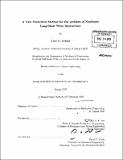| dc.contributor.advisor | Dick K. P. Yue. | en_US |
| dc.contributor.author | Kofiani, Kirki N. (Kirki Nikolaos) | en_US |
| dc.contributor.other | Massachusetts Institute of Technology. Dept. of Mechanical Engineering. | en_US |
| dc.date.accessioned | 2010-05-25T21:13:56Z | |
| dc.date.available | 2010-05-25T21:13:56Z | |
| dc.date.copyright | 2009 | en_US |
| dc.date.issued | 2009 | en_US |
| dc.identifier.uri | http://hdl.handle.net/1721.1/55275 | |
| dc.description | Thesis (S.M. in Ocean Engineering)--Massachusetts Institute of Technology, Dept. of Mechanical Engineering, 2009. | en_US |
| dc.description | Cataloged from PDF version of thesis. | en_US |
| dc.description | Includes bibliographical references (p. 98-100). | en_US |
| dc.description.abstract | The scope of this thesis is the development of a new numerical method to address the problem of nonlinear interactions of free-surface gravity waves. More specifically, this study addresses the case of wave interactions of short waves ridding on longer waves up to second order of nonlinearity M. The study of the nonlinear interactions between long and short waves is an active research area that has numerous applications. Most recently the interest on the subject has been regenerated due to the need for reliable prediction of the evolution of large-scale ocean wave-fields using remote sensing techniques for internet-based mapping applications. Accurate deduction of the ocean wave-field elevation requires detailed understanding of the modulation of the wave characteristics due to nonlinear interactions, from both a qualitative and a quantitative perspective. Initially, we will present the necessary background for the mathematical formulation of the general Nonlinear Wave Interactions (NWI) problem. We will then focus on the High-Order Spectral (HOS) method, a specific mode-coupled method used extensively for the solution of NWI. This method is studied with the objective of developing a new Mapped-Domain Spectral Method (MDSM) that plans to incorporate the strong points of the HOS method and also to extend its capabilities for a broader range of wavelength ratios of NWI. The new numerical scheme is based on the mapping of the original Boundary Value Problem (BVP) and on the devolopment of a mixed Fourier-Chebyshev spectral method for the solution of the transformed BVP, while ensuring exponential convergence with respect to the Chebyshev order of expansion K. | en_US |
| dc.description.abstract | (cont.) The investigation of the new method has been conducted for the case of two interacting waves taking into account terms up to M = 2. The results agree very well with HOS for cases of wavelength ratios up to AS/AL = 0.1, as well as for short time evolutions. For cases where either the wavelength ratio is smaller than 0.1, or the run time is significantly larger (t > 10Ts), the new method succeeds in providing results, while prior methods are limited by the appearence of divergent terms proportional to ALkS. | en_US |
| dc.description.statementofresponsibility | by Kirki N. Kofiani. | en_US |
| dc.format.extent | 100 p. | en_US |
| dc.language.iso | eng | en_US |
| dc.publisher | Massachusetts Institute of Technology | en_US |
| dc.rights | M.I.T. theses are protected by
copyright. They may be viewed from this source for any purpose, but
reproduction or distribution in any format is prohibited without written
permission. See provided URL for inquiries about permission. | en_US |
| dc.rights.uri | http://dspace.mit.edu/handle/1721.1/7582 | en_US |
| dc.subject | Mechanical Engineering. | en_US |
| dc.title | A new numerical method for the problem of nonlinear long-short wave interactions | en_US |
| dc.type | Thesis | en_US |
| dc.description.degree | S.M.in Ocean Engineering | en_US |
| dc.contributor.department | Massachusetts Institute of Technology. Department of Mechanical Engineering | |
| dc.identifier.oclc | 613222530 | en_US |

